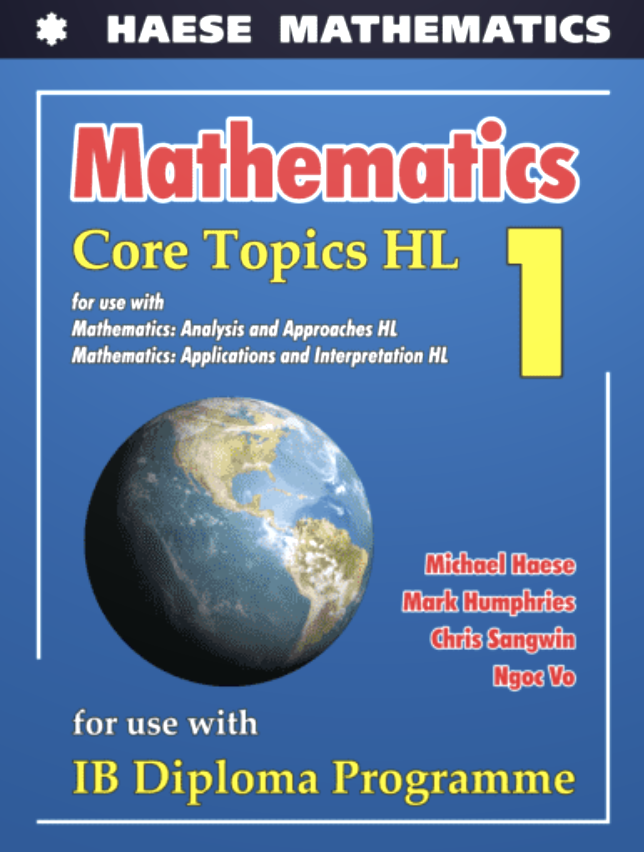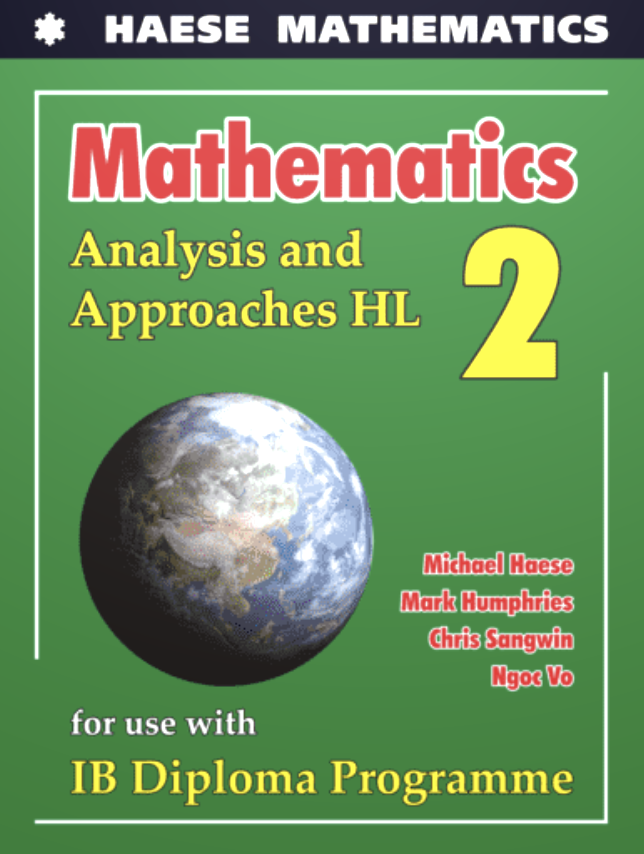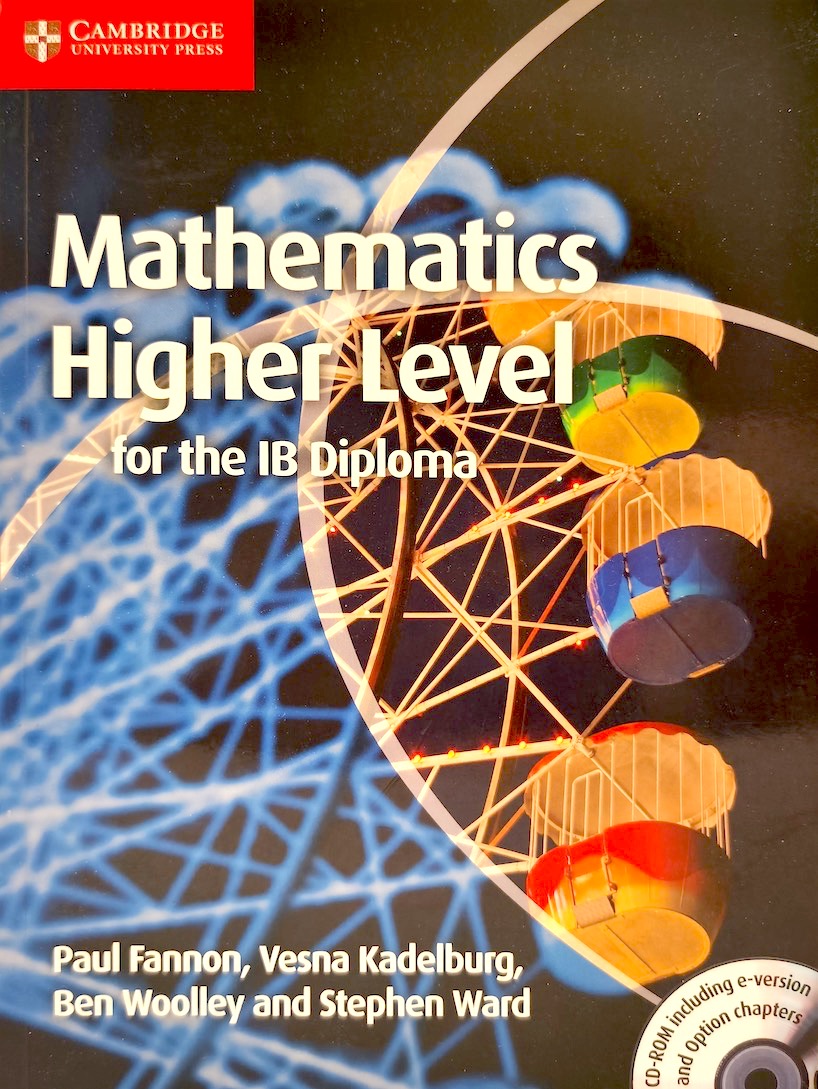Introduction
This is the 2nd post in my blog series called “My Experience & Tips for IB Textbooks”. The IB subjects covered in this series are DP Physics, Math AA, Chemistry, History, and Chinese A Lit. The corresponding levels and syllabus versions (years of first assessment) are as follows:
| Subject | Level | First Assessment | Other Posts in This Series | |
|---|---|---|---|---|
| Physics | HL | 2016 | My Experience & Tips | |
| Math AA | HL | 2021 | This article | |
| Chemistry | SL | 2016 | My Experience & Tips | |
| History | SL | 2017 | My Experience & Tips | |
| Chinese A Lit | SL | 2021 | My Experience & Tips |
All of these are the IB DP subjects that I’ve studied. I’ve used at least 2 textbooks (or study guides) for each of these subjects.
In this article, I’ll discuss the Math AA textbooks that I’ve used. I’ll list the textbooks by their publishers, compare and contrast their features, their strengths and weaknesses (in my opinion), and finally give my thoughts on how to use textbooks. All the information here is for reference only.
TL;DR is at the end of this post.
Textbook Reviews
I think good Math textbooks and good Physics textbooks are actually pretty similar. They both need to have these:
- Good explanations
- Good practice problems
So, let me talk about the Math textbooks I’ve used. In the two years of DP, I used 3 textbooks from 2 publishers.
Haese Mathematics

- Title:Mathematics: Core Topics HL
- Edition:1st Ed.
- Authors:Michael Haese, Mark Humphries, Chris Sangwin, Ngoc Vo
- ISBN:978-1-925489-58-3
As suggested by the title, this book covers the common content of AA and AI HL, as well as a very small amount of content which is AI-only and unrelated to AA at all. Some of the content in this book only scratches the surface, and the more in-depth parts are in the following textbook.

- Title:Mathematics: Analysis and Approaches HL
- Edition:1st Ed.
- Authors:Michael Haese, Mark Humphries, Chris Sangwin, Ngoc Vo
- ISBN:978-1-925489-59-0
As suggested by the title, this books covers the AA-HL-only content which is left out of the first book. The two books above are in the same series and should be used together.
- Structure
This book series splits up the syllabus content of AA HL, with a small portion in Book 1 and this large remaining portion in Book 2, creating a sharp cut-off. For example, the first book deals with the transformation of functions superficially, and doesn’t cover absolute-value transformation, square transformation, rational functions with quadratics, and so on. It’s not until Book 2 that all the transformations required in the syllabus are covered. If you’re sure you want to learn AA HL from the beginning and have not thought about AI HL, then Haese’s sectioning of the book really makes little sense and is somewhat confusing. But that can be helpful if you’re still trying to decide between AA and AI HL at the start of DP.
The book is divided into chapters so carefully that it takes almost every small point in the syllabus and puts it into a subsection. This is best illustrated by the fact that the book singles out logistic functions as a subsection under the chapter on differential equations. However, logistic functions are only one example of the curriculum when illustrating differential equations with separable variables. Although there is no harm in studying logistic functions in depth, and that did deepen my understanding of differential equations and partial fractions, still, sometimes the focus of the book is a bit hard to grasp.
Personally, I feel that there are so many chapters in this book, and they are so finely divided! For example, this book uses 4 or 5 chapters to talk about derivative calculus. Another example is chapter 12—Vectors in Book 2. This series of books separates vectors in 2D and 3D, but it’s totally possible to combine the content, because… aren’t vectors in 2D just vectors in 3D with z-coordinates equal to zero? 😂
- Explanations
There’re many things in this set that are not in the IB syllabus, such as checking for function continuity, derivability, and permutations in which some elements are repeated. When using this set of books, keep in mind that you should always follow the syllabus.
The explanations are detailed, but a bit rigid. The explanation of Euler’s method in the chapter on differential equations gave my biggest headache. This book comes up directly to say that “at each iteration of Euler’s method, we generate another point for our solution curve”, but the readers don’t even know the specifics of Euler’s method, so when they see the word iteration, they’ll only get lost, won’t they?
To be honest, the style of explanation in this book is a bit like that in the Chinese high school math textbook (2007 edition) published by People’s Education Press (PEP), where concepts are often introduced through quick examples and then directly followed by formulas and problems, although Haese’s book has more textual explanations. This style is not bad, but Haese’s proofs are usually not as detailed as that of PEP’s textbook. An example is the proof for the distributive law in vector dot products. Haese uses exercises to let the readers come up with the proof themselves, but the full proof is not included in the answers at the end of the book. So, while the book is not completely free of proofs, if you want to see complete proofs, then that’s a problem.
Probably for the IB’s “international understanding”, this textbook includes a lot of content on the history of mathematics. While it is actually quite interesting, and we should really learn more or less about the development of mathematics in the world, the content is laid out in a standard format that is mixed in with the explanations in the book, rather than as separate sections, which makes it confusing. While for TOK, there are separate sections in this book series, which makes it feel clearer and more reader-friendly.
The e-version of the book also has step-by-step audio and visual explanations for each example problem. I haven’t used this self-tutoring function much, but if you prefer someone to explain the book out loud instead of reading it yourself, then this might be helpful.
- Practice problems
Lots of practice problems, and I think they are all original. There’re practice problems after each section, and two sets of comprehensive review questions of different difficulty at the end of each chapter. However, these questions do not mimic the IB question style and often have less step-by-step guidance than the IB ones, so they’re relatively more difficult. But when you have enough free time, it’s also helpful to look at different types of questions to open up your mind.
The latest edition of this book series comes with three sets of trial exam papers targeting IB P1, P2, and P3, and it also includes some additional practice questions for P3. Nonetheless, there are still some problems. The P1 and P2 questions are still more difficult than typical IB questions, and the P3 questions seem to have more content per question than the IB ones, so time will be tighter. However, these questions can be used as additional revision material while you go through the IB past papers. Especially, the P3 practice questions in these sets can be helpful, given how limited the past papers are.
- Other materials
The e-book is very convenient, and it allows you to take notes and use the online tools, such as the data analysis tool and the graphing tool. I really like the online simulations that come with this book, especially the one for conic sections that is introduced as an extension when starting quadratic functions. Seeing 3D cones being cut by a plane on the computer is really more helpful than drawing it yourself on paper and imagining it in your head, and it’s also so much easier than making the cones and cuts by hand.
Cambridge University Press

- Title:Mathematics for the IB Diploma: Higher Level
- Edition:2012 Ed.
- Authors:Paul Fannon, Vesna Kadelburg, Ben Woolley, Stephen Ward
- ISBN:978-1-107-66173-8
- Structure
This book was written for the old Math HL syllabus, which was first assessed in 2014, and instead of writing a new textbook for the new syllabus, Cambridge has made a table that maps the content in the new syllabus with the chapters in the old textbook.
Although the book is not divided into chapters for the new syllabus, each chapter corresponds to almost every section of requirements in the new syllabus. The chapters are also clearer than Haese’s, because the book is not arbitrarily divided into two books, as Haese has done, making the content fragmented.
Moreover, this book does not contain unnecessary details. I mentioned how Haese had different sections for vectors in 2D and 3D, so here’s another example: this book does not separate “3D geometry without vectors” and “3D geometry with vectors” as Haese has done. For AA HL, Haese’s division is not necessary at all. And this book categorizes chapters into broad topics like algebra, equations and functions, geometry, calculus, statistics and probability, while Haese does not.
The book also has a summary for each chapter, but I haven’t used it much because I personally don’t find it very helpful to read other people’s summaries. But this is indeed what’s missing from Haese’s textbook.
- Explanations
This book originally targeted the old syllabus, so there’re inevitably extra or missing sections in it when you study the new syllabus. Note that most of the calculus content in the new syllabus comes from the optional calculus chapters in the old syllabus, while the optional chapters of this book are only included in the e-book on the CD at the back of the paper copy.
The explanations in this book are usually very natural, which I personally feel to be better than Haese. For example, the explanation of Euler’s method in the chapter on differential equations. The book starts by drawing jagged lines, walking the reader slowly through the steps of Euler’s method, visually illustrating the knowledge and then summarizing it in a more mathematically rigorous way. At least for me, this makes it easier to learn new knowledge.
One thing that makes me feel comfortable using this book is that it has many accompanying proofs, both fill-in-the-blank versions and completed ones. Moreover, it has some proofs that are not in Haese’s textbook, such as the formula $Var(X)=np(1-p)$ for the variance of the binomial distribution $X\sim{B(n,p)}$ , as well as the product rule for differentiation. However, these proofs are included in the e-book.
- Practice problems
Enough practice problems. Overall, I found the problems in this book more suitable for exam preparation than Haese’s, although they are not perfect.
There are exercises after each section, with non-IB style questions to familiarize you with the concepts, as well as IB style questions. Each chapter is followed by a more comprehensive problem set, and there is even a special chapter to provide problems that crosses topics. These include both long and short response questions in the IB style. There are also free chapter tests available on the Cambridge website, which can be accessed by registering for a free account. These problems are in the IB style and are similar in difficulty to those in IB exams.
The book also color codes all the questions in green, blue, and red to indicate the difficulty and type of questions, and also shows the calculator requirements, which was very helpful when I did problems for revision, while Haese does not have these features. The e-book also comes with more Extension worksheets, but not in the IB style.
This book doesn’t have complete trial exam papers and mark schemes like Haese does, so that’s a con. But it’s not a big problems, because you can always make up for it by doing the real IB exam papers.
- Other materials
As I mentioned before, this book doesn’t come with trial exam papers, but its online materials include more, like assessment papers for each chapter. Its e-book has many additional things, too, such as proofs (fill-in and completed versions), extension worksheets, supplementary materials, self-discovery sheets, etc. The e-book also has problems related to prior learning, which I think is helpful for you to check for gaps before you start the DP.
This book has some drawbacks though. Its e-book is not on cloud so it doesn’t update or correct the mistakes automatically. The e-book is simply a collection of PDF documents, so it doesn’t have math tools or simulations like Haese’s.
Using the Textbooks
Because neither of the textbooks I mentioned above cover the IB syllabus perfectly, I recommend you use the syllabus itself as your first reference source.
I think the best way of using textbooks is like this. When you learn, you look at the syllabus first, and then look at the explanations in both textbooks together (but look at Cambridge’s explanation first). Later, you can use Haese’s problems and Cambridge’s non-IB-style problems to quickly familiarize yourself with the new concepts. To solidify your knowledge, you can use Cambridge’s IB-style problems. And for exam preparation (mainly at the final stage of IB DP), you can use Haese’s trial exam papers and Cambridge’s IB-style problems.
If both books cover a topic, I prefer to read the Cambridge explanation first because it is more natural, and then I read Haese’s explanation to check for gaps. However, this is only a personal preference, and there are some topics in the new syllabus that only appear in Haese’s textbook, such as augmented matrices in linear algebra. During the past two years of DP, when studying some topics, although I only read Haese’s explanations and not Cambridge’s, I didn’t have any difficulties or have any major problems.
Unfortunately, I haven’t used the Math AA textbook published by Oxford University Press, so I can’t comment on it here. But maybe it covered the IB syllabus better.
Conclusion
In this article, I talked about 2 Math AA textbooks for the 2021 IB DP syllabus. The books are published by Haese and Cambridge respectively. I listed out their features, compared and contrasted the strengths and weaknesses of each of them in my mind. Throughout the process, I tried to reference to concrete examples. At the end, based on my own learning experience, I gave some suggestions for using textbooks. It’s a shame that this article did not include the Oxford textbook, which is similarly quite mainstream.
I’m still updating this series of blog posts, and I’ll post links to the new updates in the table at the beginning of this blog post. Feel free to check them out if you’re interested!
This article doesn’t cover any specific math study methods, such as how to organize problems you did wrong, nor does it cover specific tips for studying IB Math, such as exam skills. All of these I will mention in future blog posts. For more posts on the IB DP course, Math AA, or on math, please use the “tabs” function on the sidebar of this blog.
Thank you for reading! I’m not a teacher but just an IB student who has bits of thoughts. If you have different opinions or more insights, feel free to discuss or share them here! (Also look for contact information at the end of the “About” section of this blog.) I’m really curious about what other people think! If you have used the textbooks I mentioned here, the Oxford textbook, or any other textbooks, you are welcomed to share and discuss!
TL;DR
Main Features of Each Textbook
| Publisher | Structure | Explanations | Practice Problems | Other Materials |
|---|---|---|---|---|
| Haese | Finer section division; Split in 2 books | More rigid, or direct | Only trial exam papers (in the latest version) are in IB-style; Usually harder; With P3 practice | Online ebook updates automatically; Online math tools |
| Cambridge | Written for the old syllabus, can work for the new one but there’re things missing; Chapter summaries | More natural; More proofs | Many in IB-style; Usually parallel the IB difficulty | Many additional problems & reading materials |
Recommended Way of Using the Textbooks
- Refer to the IB syllabus;
- Look at the explanations of both books together, and when they both cover a topic, look at Cambridge first;
- Familiarizing with concepts: Haese’s practice problems, Cambridge’s non-IB-style problems
- Exam preparation: Cambridge’s IB-style problems, Haese’s trial exam papers
